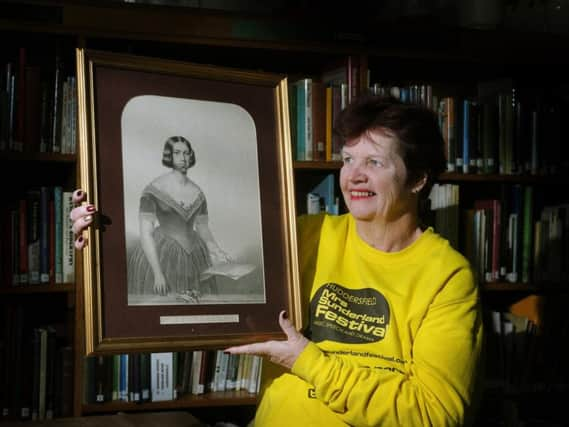Music festival named after Calderdale's Susannah Sunderland going strong after 130 years


Queen Victoria could hardly contain herself after she heard Susannah Sunderland sing the National Anthem. “I may be the Queen of England,” she told the statuesque soprano at the opening of Leeds Town Hall in 1858. “But you are the Queen of Song.”
At the time few would have disagreed. The 200th anniversary of Mrs Sunderland’s birth in Brighouse is being marked this month at the annual Huddersfield festival named after her, was among the most famous singers of her day.
Advertisement
Hide AdAdvertisement
Hide AdKnown as “The Calderdale Nightingale”, she was celebrated for both her reputedly “epic” voice and her similarly epic girth. As her “heroic proportions” increased over the years, audiences came to her concerts to gaze in awe, convinced that she might at any moment keel over.
The Mrs Sunderland Festival, now in its 130th year, will be launched tomorrow with a one-off “come and sing” workshop on Handel’s Messiah with Huddersfield Choral Society, followed by an evening performance.
The festival then takes a break until February 13, when over ten days some 4,000 performers from all over the country will head to Huddersfield Town Hall, its ornately decorated organ towering over them like a gigantic pink and gold wedding cake.
At the festival’s heart is a music competition (Britain’s second oldest and one of its biggest) with more than 100 sections for pianists, other instrumentalists, singers and choirs. Plus a speech and drama section, won in the past by the Huddersfield-born Hollywood star James Mason and Coronation Street’s Thelma Barlow.
Advertisement
Hide AdAdvertisement
Hide AdMore than 130 or so highly polished cups, shields and rose bowls will be waiting to be won. Choose from the AW & Daisy M Kaye Memorial Trophy, the A Haigh Shield (“originally for Townswomen’s Guild classes”) and the Inner Wheel Club of Huddersfield Trophy. Or the Sowerby Bridge Gilbert and Sullivan Society Trophy, the Mabel Whiteley Rose Bowl and the Madame K Haws Trophy.
Until a few years ago, the festival was known as the Mrs Sunderland Musical Competition. That was accurate, but also potentially off-putting with its whiff of fusty antimacassared Victorian formality.
“When you spoke to people in Huddersfield, they either hadn’t heard of it – which I can’t believe when it’s been going for 130 years – or they remember a dry and dusty competition, all classical music,” says Ann Talboys, the highly focused, engagingly enthusiastic festival administrator.
“We don’t want it to be seen as an old fuddy-duddy festival – because it’s not. So we decided to move it into the 21st century and make it much more family-orientated with a more upbeat atmosphere.”
Advertisement
Hide AdAdvertisement
Hide Ad“Mrs Sunderland” attendants now wear bright yellow sweatshirts and inclusivity is high on the agenda This year there’s a tea dance for dementia sufferers and their carers, a special needs workshop, and a Key Stage Two day, with 900 children from more than 30 schools singing songs from shows and films.
“And the dialect class always brings in a big audience, with people performing humorous poetry and prose – usually it’s Yorkshire dialect and there’s a big contingent from Barnsley,” says Ann, who reckons that during the festival, “I basically live in the Town Hall for ten days.”
As well as more than 100 choral, instrumental and vocal classes (many geared to children – some as young as five), there’s now The Magic of Walt Disney, ukulele groups, and pop ballads, perhaps featuring Mariah Carey, Rihanna and Adele numbers.
“If people want to play Chopin on the Steinway, that’s great. If they want to sing pop ballads, that’s great too. It’s quite cool to sing these days,” says Ann. ”I think Mrs Sunderland would have loved it.”
Advertisement
Hide AdAdvertisement
Hide AdSo who was Mrs Sunderland? The Yorkshire Queen of Song, as she became widely known courtesy of Queen Victoria, was a gardener’s daughter, born Susannah Sykes in 1819.
When she was 12, she was singing in her parents’ Brighouse garden and overheard by Luke Settle, a blacksmith and singer. He offered to train her, she made her debut two years later and became an early member of Huddersfield Choral Society. She performed across Britain but never moved from Brighouse.
She marked her 1864 retirement with a year-long series of farewell recitals. They went well, but her last concert with the Choral Society caused controversy. She was unhappy with the society’s “generous” £35 fee and some thought she revealed “a mercenary disposition” by trying to bargain.
Her golden wedding anniversary in 1888 was marked by a concert that led to the launch of the competition, and the “veteran cantatrice”, as the Brighouse Echo called her, died in 1905.
Advertisement
Hide AdAdvertisement
Hide AdOver the years, the festival’s national newspaper coverage has included a colourful Times preview in 1972. “New scores to be settled on the concert platform are being hummed and grunted by bank clerks and housewives and textile men and school teachers and the whole great mixture of folk who in Huddersfield, once a week at least, turn into musicians,” wrote Ronald Faux.
“There is a maxim in the town that if you can’t sing you can blow and if you can’t blow you can listen... Huddersfield surely has more music to the acre than any place of similar size in the country.”
Particularly when the “Mrs Sunderland” is in town.
With thanks to Robert Clegg and Rosie Hall at the West Yorkshire Archive Service Kirklees, based in Huddersfield Library.